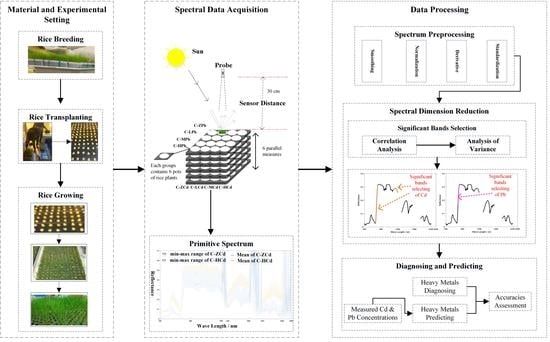Rapid Identification and Prediction of Cadmium-Lead Cross-Stress of Different Stress Levels in Rice Canopy Based on Visible and Near-Infrared Spectroscopy
Abstract
:1. Introduction
2. Materials and Methods
2.1. Experimental Design
2.2. Spectrum and Cd–Pb Contents in Leaf Measurement
2.3. Spectral Pre-Processing
2.4. Spectral Dimension Reduction
2.5. Model Calibration
2.5.1. Diagnosis of Heavy Metals
2.5.2. Prediction of Cd–Pb Contents
2.6. Model Evaluation
2.6.1. Diagnostic Models Evaluation
2.6.2. Predictive Models Evaluation
3. Results
3.1. Leaf Cd–Pb Contents
3.2. Significant Bands
3.3. Spectral Response to Single Contamination
3.4. Diagnosis of Cd–Pb Cross-Stress with Different Stress Levels
3.5. Predictions Cd and Pb Contents
4. Discussion
4.1. Comparisons of Pre-Processing Methods
4.2. Comparisons of Estimated Models
4.3. Investigations of Limits and Future Study
5. Conclusions
Author Contributions
Funding
Acknowledgments
Conflicts of Interest
References
- Farias, C.O.; Hamacher, C.; Wagener, A.D.L.R.; Campos, R.C.D.; Godoy, J.M. Trace metal contamination in mangrove sediments, Guanabara Bay, Rio de Janeiro, Brazil. J. Braz. Chem. Soc. 2007, 18, 1194–1206. [Google Scholar] [CrossRef]
- Leenaers, H.; Okx, J.P.; Burrough, P.A. Employing elevation data for efficient mapping of soil pollution on floodplains. Soil Use Manag. 1990, 6, 105–114. [Google Scholar] [CrossRef]
- Steiger, B.V.; Webster, R.; Schulin, R.; Lehmann, R. Mapping heavy metals in polluted soil by disjunctive kriging. Environ. Pollut. 1996, 94, 205–215. [Google Scholar] [CrossRef]
- Liu, Y.; Li, W.; Wu, G.; Xu, X. Feasibility of estimating heavy metal contaminations in floodplain soils using laboratory-based hyperspectral data—A case study along Le’an River, China. Geo-Spat. Inf. Sci. 2011, 14, 10–16. [Google Scholar] [CrossRef] [Green Version]
- Rossel, R.A.V.; Walvoort, D.J.J.; Mcbratney, A.B.; Janik, L.J.; Skjemstad, J.O. Visible, near infrared, mid infrared or combined diffuse reflectance spectroscopy for simultaneous assessment of various soil properties. Geoderma 2006, 131, 59–75. [Google Scholar] [CrossRef]
- Allory, V.; Cambou, A.; Moulin, P.; Schwartz, C.; Cannavo, P.; Vidal-Beaudet, L.; Barthes, B.G. Quantification of soil organic carbon stock in urban soils using visible and near infrared reflectance spectroscopy (VNIRS) in situ or in laboratory conditions. Sci. Total Environ. 2019, 686, 764–773. [Google Scholar] [CrossRef] [PubMed] [Green Version]
- Kooistra, L.; Wehrens, R.; Leuven, R.S.; Buydens, L.M. Possibilities of visible–near-infrared spectroscopy for the assessment of soil contamination in river floodplains. Anal. Chim. Acta 2001, 446, 97–105. [Google Scholar] [CrossRef]
- Stenberg, B.; Rossel, R.V.; Mouazen, A.; Wetterlind, J. Visible and near infrared spectroscopy in soil science. Adv. Agron. 2010, 107, 163–215. [Google Scholar]
- Ren, Y.H.; Zhuang, D.F.; Singh, A.N.; Pan, J.J.; Qiu, D.S.; Shi, R.H. Estimation of As and Cu contamination in agricultural soils around a mining area by reflectance spectroscopy: A case study. Pedosphere 2009, 19, 719–726. [Google Scholar] [CrossRef]
- Bray, J.G.; Rossel, R.A.V.; McBratney, A.B. Diagnostic Screening of Urban Soil Contaminants Using Diffuse Reflectance Spectroscopy. Aust. J. Soil Res. 2010, 47, 43. [Google Scholar]
- Hong, Y.; Shen, R.; Cheng, H.; Chen, Y.; Zhang, Y.; Liu, Y.; Zhou, M.; Yu, L.; Liu, Y.; Liu, Y. Estimating lead and zinc concentrations in peri-urban agricultural soils through reflectance spectroscopy: Effects of fractional-order derivative and random forest. Sci. Total Environ. 2019, 651 Pt 2, 1969–1982. [Google Scholar] [CrossRef]
- Chen, T.; Chang, Q.; Clevers, J.G.; Kooistra, L. Rapid identification of soil cadmium pollution risk at regional scale based on visible and near-infrared spectroscopy. Environ. Pollut. 2015, 206, 217–226. [Google Scholar] [CrossRef] [PubMed]
- Wang, J.; Cui, L.; Gao, W.; Shi, T.; Chen, Y.; Gao, Y. Prediction of low heavy metal concentrations in agricultural soils using visible and near-infrared reflectance spectroscopy. Geoderma 2014, 216, 1–9. [Google Scholar] [CrossRef]
- Sun, W.; Skidmore, A.K.; Wang, T.; Zhang, X. Heavy metal pollution at mine sites estimated from reflectance spectroscopy following correction for skewed data. Environ. Pollut. 2019, 252 Pt B, 1117–1124. [Google Scholar] [CrossRef]
- Kemper, T.; Sommer, S. Estimate of heavy metal contamination in soils after a mining accident using reflectance spectroscopy. Environ. Sci. Technol. 2002, 36, 2742. [Google Scholar] [CrossRef]
- Wu, Z.Y.; Chen, J.; Ji, J.F.; Tian, Q.J.; Wu, X.M. Feasibility of reflectance spectroscopy for the assessment of soil mercury contamination. Environ. Sci. Technol. 2005, 39, 873–878. [Google Scholar] [CrossRef]
- Liu, M.; Liu, X.; Ding, W.; Wu, L. Monitoring stress levels on rice with heavy metal pollution from hyperspectral reflectance data using wavelet-fractal analysis. Int. J. Appl. Earth Obs. Geoinf. 2011, 13, 246–255. [Google Scholar] [CrossRef]
- Shi, T.; Chen, Y.; Liu, Y.; Wu, G. Visible and near-infrared reflectance spectroscopy-an alternative for monitoring soil contamination by heavy metals. J. Hazard Mater. 2014, 265, 166–176. [Google Scholar] [CrossRef]
- Shi, T.; Liu, H.; Chen, Y.; Fei, T.; Wang, J.; Wu, G. Spectroscopic Diagnosis of Arsenic Contamination in Agricultural Soils. Sensors 2017, 17, 1036. [Google Scholar] [CrossRef] [PubMed] [Green Version]
- Liu, M.; Liu, X.; Wu, L.; Duan, L.; Zhong, B. Wavelet-based detection of crop zinc stress assessment using hyperspectral reflectance. Comput. Geosci. 2011, 37, 1254–1263. [Google Scholar] [CrossRef]
- Zhang, S.; Fei, T.; Ran, Y. Diagnosis of Heavy Metal cross Contamination in Leaf of Rice Based on Hyperspectral Image: A Greenhouse Experiment. In Proceedings of the 2018 IEEE International Conference on Advanced Manufacturing (ICAM), Yunlin, China, 16 November 2018. [Google Scholar]
- Chakraborty, S.; Weindorf, D.C.; Deb, S.; Li, B.; Paul, S.; Choudhury, A.; Ray, D.P. Rapid assessment of regional soil arsenic pollution risk via diffuse reflectance spectroscopy. Geoderma 2017, 289, 72–81. [Google Scholar] [CrossRef]
- Sun, W.; Zhang, X. Estimating soil zinc concentrations using reflectance spectroscopy. Int. J. Appl. Earth Obs. Geoinf. 2017, 58, 126–133. [Google Scholar] [CrossRef]
- Fu, J.; Zhou, Q.; Liu, J.; Liu, W.; Wang, T.; Zhang, Q.; Jiang, G. High levels of heavy metals in rice (Oryza sativa L.) from a typical E-waste recycling area in southeast China and its potential risk to human health. Chemosphere 2008, 71, 1269–1275. [Google Scholar] [PubMed]
- Cheng, F.; Zhao, N.; Xu, H.; Li, Y.; Zhang, W.; Zhu, Z.; Chen, M. Cadmium and lead contamination in japonica rice grains and its variation among the different locations in southeast China. Sci. Total Environ. 2006, 359, 156–166. [Google Scholar]
- Keawkim, K.K.; Chuanuwatanakul, S.; Chailapakul, O.; Motomizu, S. Determination of lead and cadmium in rice samples by sequential injection/anodic stripping voltammetry using a bismuth film/crown ether/Nafion modified screen-printed carbon electrode. Food Control 2013, 31, 14–21. [Google Scholar] [CrossRef]
- Malley, F.D.; Williams, P.C. Use of Near-Infrared Reflectance Spectroscopy in Prediction of Heavy Metals in Freshwater Sediment by Their Association with Organic Matter. Environ. Sci. Technol. 1997, 31, 3461–3467. [Google Scholar] [CrossRef]
- Choe, E.; van der Meer, F.; van Ruitenbeek, F.; van der Werff, H.; de Smeth, B.; Kim, K.-W. Mapping of heavy metal pollution in stream sediments using combined geochemistry, field spectroscopy, and hyperspectral remote sensing: A case study of the Rodalquilar mining area, SE Spain. Remote Sens. Environ. 2008, 112, 3222–3233. [Google Scholar] [CrossRef]
- Gannouni, S.; Rebai, N.; Abdeljaoued, S. A Spectroscopic Approach to Assess Heavy Metals Contents of the Mine Waste of Jalta and Bougrine in the North of Tunisia. J. Geogr. Inf. Syst. 2012, 4, 242–253. [Google Scholar] [CrossRef] [Green Version]
- Vohland, M.; Bossung, C.; Fründ, H.C. A spectroscopic approach to assess trace-heavy metal contents in contaminated floodplain soils via spectrally active soil components. J. Plant Nutr. Soil Sci. 2009, 172, 201–209. [Google Scholar] [CrossRef]
- Wu, Y.; Chen, J.; Ji, J.; Gong, P.; Liao, Q.; Tian, Q.; Ma, H. A Mechanism Study of Reflectance Spectroscopy for Investigating Heavy Metals in Soils. Soil Sci. Soc. Am. J. 2007, 71, 918–926. [Google Scholar] [CrossRef]
- Wu, Y.; Zhang, X.; Liao, Q.; Ji, J. Can Contaminant Elements in Soils Be Assessed by Remote Sensing Technology: A Case Study With Simulated Data. Soil Sci. 2011, 176, 196–205. [Google Scholar] [CrossRef]
- Wu, Y.; Chen, J.; Wu, X.; Tian, Q.; Ji, J.; Qin, Z. Possibilities of reflectance spectroscopy for the assessment of contaminant elements in suburban soils. Appl. Geochem. 2005, 20, 1051–1059. [Google Scholar] [CrossRef]
- Shi, T.; Wang, J.; Chen, Y.; Wu, G. Improving the prediction of arsenic contents in agricultural soils by combining the reflectance spectroscopy of soils and rice plants. Int. J. Appl. Earth Obs. Geoinf. 2016, 52, 95–103. [Google Scholar] [CrossRef]
- Liu, M.; Liu, X.; Li, J.; Li, T. Estimating regional heavy metal concentrations in rice by scaling up a field-scale heavy metal assessment model. Int. J. Appl. Earth Obs. Geoinf. 2012, 19, 12–23. [Google Scholar] [CrossRef]
- Chang, C.; Laird, D.A.; Mausbach, M.J.; Hurburgh, C.R. Near-Infrared Reflectance Spectroscopy–Principal Components Regression Analyses of Soil Properties. Soil Sci. Soc. Am. J. 2001, 65, 480–490. [Google Scholar] [CrossRef] [Green Version]
- Mouazen, M.A.; Kuang, B.; Baerdemaeker, J.D.; Ramon, H.; Guerrero, C.; Rossel, R.A.V.; Mouazen, A.M. Comparison among principal component, partial least squares and back propagation neural network analyses for accuracy of measurement of selected soil properties with visible and near infrared spectroscopy. Geoderma 2010, 158, 23–31. [Google Scholar] [CrossRef]
- Tsakiridis, L.N.; Tziolas, N.V.; Theocharis, J.B.; Zalidis, G.C. A genetic algorithm-based stacking algorithm for predicting soil organic matter from vis–NIR spectral data. Eur. J. Soil Sci. 2019, 70, 578–590. [Google Scholar] [CrossRef]
- Tziolas, N.; Tsakiridis, N.; Ben-Dor, E.; Theocharis, J.; Zalidis, G. A memory-based learning approach utilizing combined spectral sources and geographical proximity for improved VIS-NIR-SWIR soil properties estimation. Geoderma 2019, 340, 11–24. [Google Scholar] [CrossRef]
- Mitchell, J.J.; Glenn, N.F.; Sankey, T.T.; Derryberry, D.R.; Germino, M.J. Remote sensing of sagebrush canopy nitrogen. Remote Sens. Environ. 2012, 124, 217–223. [Google Scholar] [CrossRef] [Green Version]
- Liu, J.; Han, J.; Xie, J.; Wang, H.; Tong, W.; Ba, Y. Assessing heavy metal concentrations in earth-cumulic-orthic-anthrosols soils using Vis-NIR spectroscopy transform coupled with chemometrics. Spectrochim. Acta A Mol. Biomol. Spectrosc. 2020, 226, 117639. [Google Scholar] [CrossRef]
- Jiang, Q.; Liu, M.; Wang, J.; Liu, F. Feasibility of using visible and near-infrared reflectance spectroscopy to monitor heavy metal contaminants in urban lake sediment. Catena 2018, 162, 72–79. [Google Scholar] [CrossRef]
- Qian, Y.; Chen, C.; Zhang, Q.; Li, Y.; Chen, Z.; Li, M. Concentrations of cadmium, lead, mercury and arsenic in Chinese market milled rice and associated population health risk. Food Control 2010, 21, 1757–1763. [Google Scholar] [CrossRef]
- Xie, H.L.; Tang, S.Q.; Wei, X.J.; Shao, G.N.; Jiao, G.A.; Sheng, Z.H.; Luo, J.; Hu, P.S. The cadmium and lead content of the grain produced by leading Chinese rice cultivars. Food Chem. 2017, 217, 217–224. [Google Scholar] [CrossRef] [PubMed]
- MEE; SAMR. Risk Control Standard for Soil Contamination of Agricultural Land 2018; Standards Press of China: Beijing, China, 2018; pp. 1–7. [Google Scholar]
- Shi, T.; Liu, H.; Chen, Y.; Wang, J.; Wu, G. Estimation of arsenic in agricultural soils using hyperspectral vegetation indices of rice. J. Hazard. Mater. 2016, 308, 243–252. [Google Scholar] [CrossRef]
- Savitzky, A.; Golay, M.J.E. Smoothing and Differentiation of Data by Simplified Least Squares Procedures. Anal. Chem. 1964, 36, 1627–1639. [Google Scholar] [CrossRef]
- Kampichler, C.; Wieland, R.; Calmé, S.; Weissenberger, H.; Arriaga-Weiss, S. Classification in conservation biology: A comparison of five machine-learning methods. Ecol. Inform. 2010, 5, 441–450. [Google Scholar] [CrossRef]
- Haaland, M.D.; Thomas, E.V. Partial least-squares methods for spectral analyses. 1. Relation to other quantitative calibration methods and the extraction of qualitative information. Anal. Chem. 1988, 60, 1193–1202. [Google Scholar] [CrossRef]
- Darvishzadeh, R.; Skidmore, A.; Schlerf, M.; Atzberger, C.; Corsi, F.; Cho, M. LAI and chlorophyll estimation for a heterogeneous grassland using hyperspectral measurements. Isprs J. Photogramm. Remote Sens. 2008, 63, 409–426. [Google Scholar] [CrossRef]
- Schlerf, M.; Atzberger, C.; Hill, J. Remote sensing of forest biophysical variables using HyMap imaging spectrometer data. Remote Sens. Environ. 2005, 95, 177–194. [Google Scholar] [CrossRef] [Green Version]
- Bellon-Maurel, V.; Fernandez-Ahumada, E.; Palagos, B.; Roger, J.-M.; McBratney, A. Critical review of chemometric indicators commonly used for assessing the quality of the prediction of soil attributes by NIR spectroscopy. TrAC Trends Anal. Chem. 2010, 29, 1073–1081. [Google Scholar] [CrossRef]
- He, L.; Zhang, H.Y.; Zhang, Y.S.; Song, X.; Feng, W.; Kang, G.Z.; Wang, C.Y.; Guo, T.C. Estimating canopy leaf nitrogen concentration in winter wheat based on multi-angular hyperspectral remote sensing. Eur. J. Agron. 2016, 73, 170–185. [Google Scholar] [CrossRef]
- Kooistra, L.; Salas, E.A.L.; Clevers, J.G.P.W.; Wehrens, R.; Leuven, R.S.E.W.; Nienhuis, P.H.; Buydens, L.M.C. Exploring field vegetation reflectance as an indicator of soil contamination in river floodplains. Environ. Pollut. 2004, 127, 281–290. [Google Scholar] [CrossRef]
- Wang, T.; Wei, H.; Zhou, C.; Gu, Y.; Li, R.; Chen, H.; Ma, W. Estimating cadmium concentration in the edible part of Capsicum annuum using hyperspectral models. Environ. Monit. Assess. 2017, 189, 548. [Google Scholar] [CrossRef]
- Cheng, H.; Shen, R.; Chen, Y.; Wan, Q.; Shi, T.; Wang, J.; Wan, Y.; Hong, Y.; Li, X. Estimating heavy metal concentrations in suburban soils with reflectance spectroscopy. Geoderma 2019, 336, 59–67. [Google Scholar] [CrossRef]
- Mutanga, O.; Skidmore, A.K. Hyperspectral band depth analysis for a better estimation of grass biomass (Cenchrus ciliaris) measured under controlled laboratory conditions. Int. J. Appl. Earth Obs. Geoinf. 2004, 5, 87–96. [Google Scholar] [CrossRef]
- Curran, P. Remote sensing of foliar chemistry. Remote Sens. Environ. 1990, 30, 271–278. [Google Scholar] [CrossRef]
- Kemper, T.; Ehlers, M.; Sommer, S.; Posa, F.; Kaufmann, H.J.; Michel, U.; de Carolis, G. Use of airborne hyperspectral data to estimate residual heavy metal contamination and acidification potential in the Guadiamar floodplain Andalusia, Spain after the Aznacollar mining accident. In Proceedings of the Remote Sensing for Environmental Monitoring, GIS Applications, and Geology IV, International Society for Optics and Photonics, Canary Islands, Spain, 22 October 2004; Volume 5574, pp. 224–234. [Google Scholar]
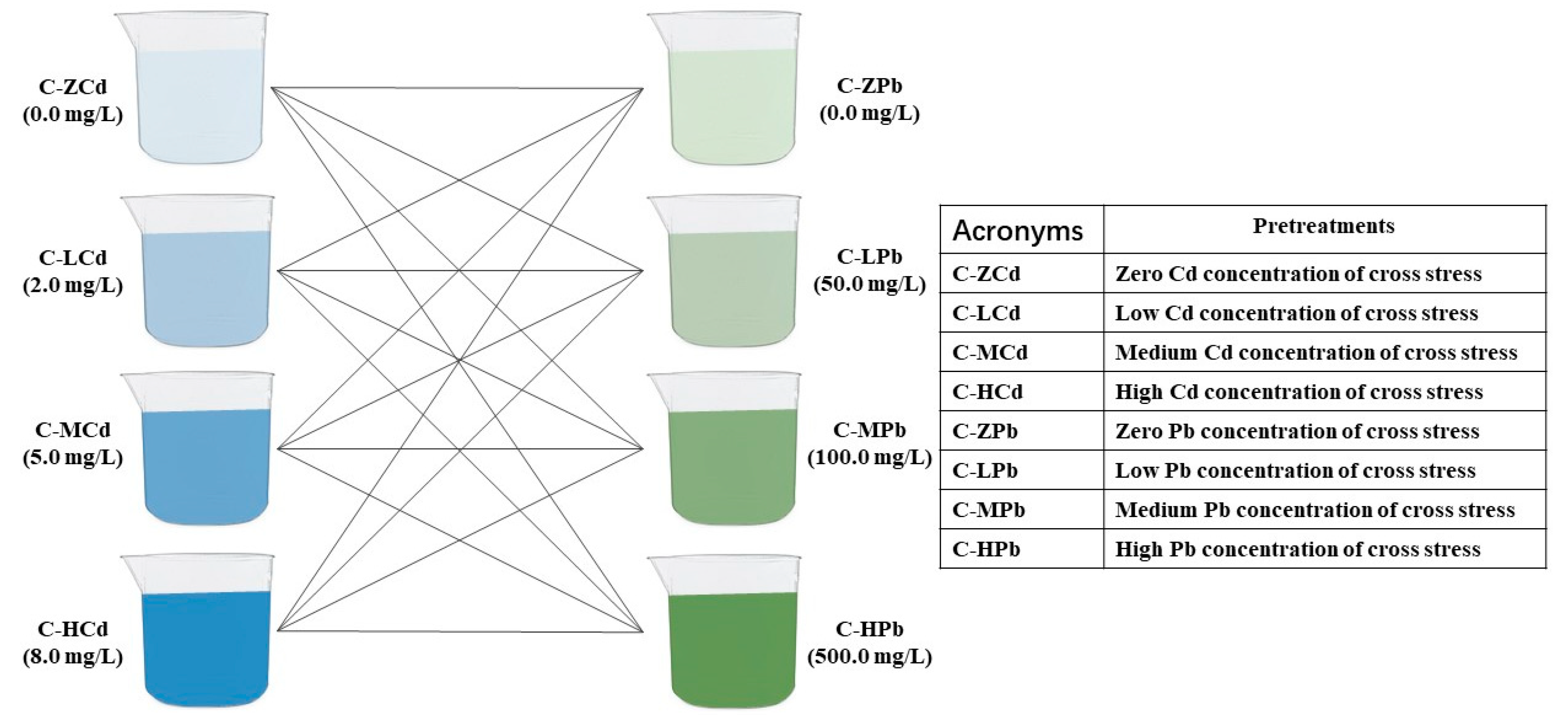
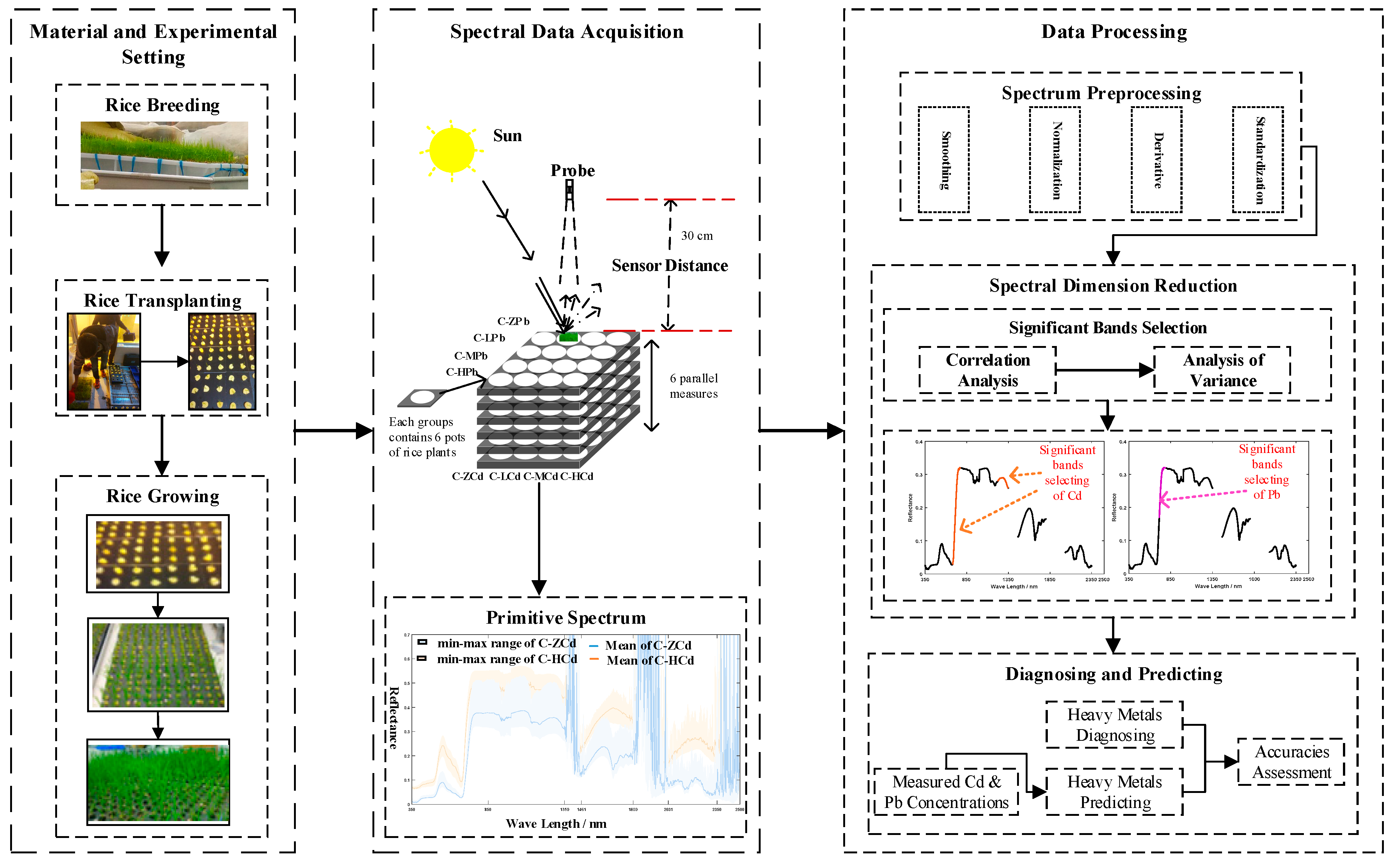
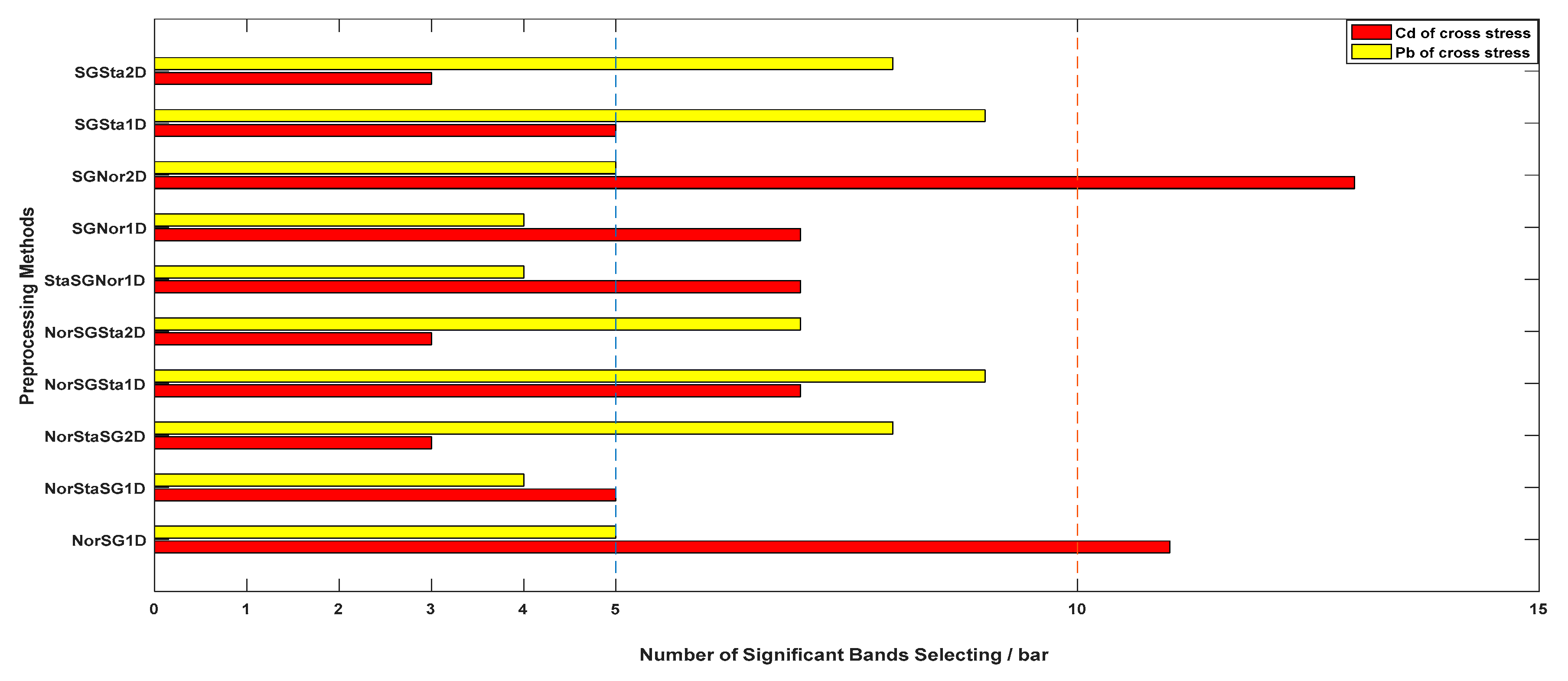

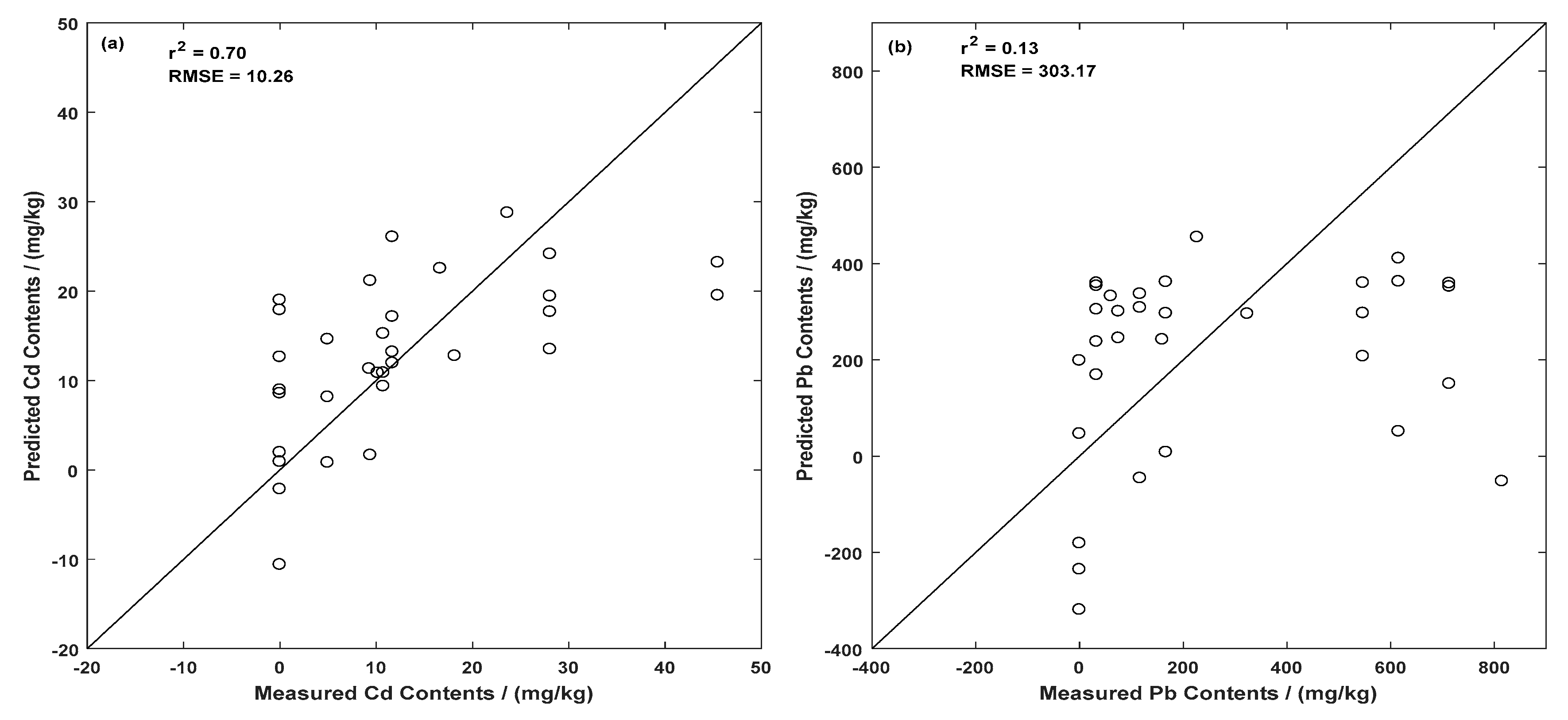
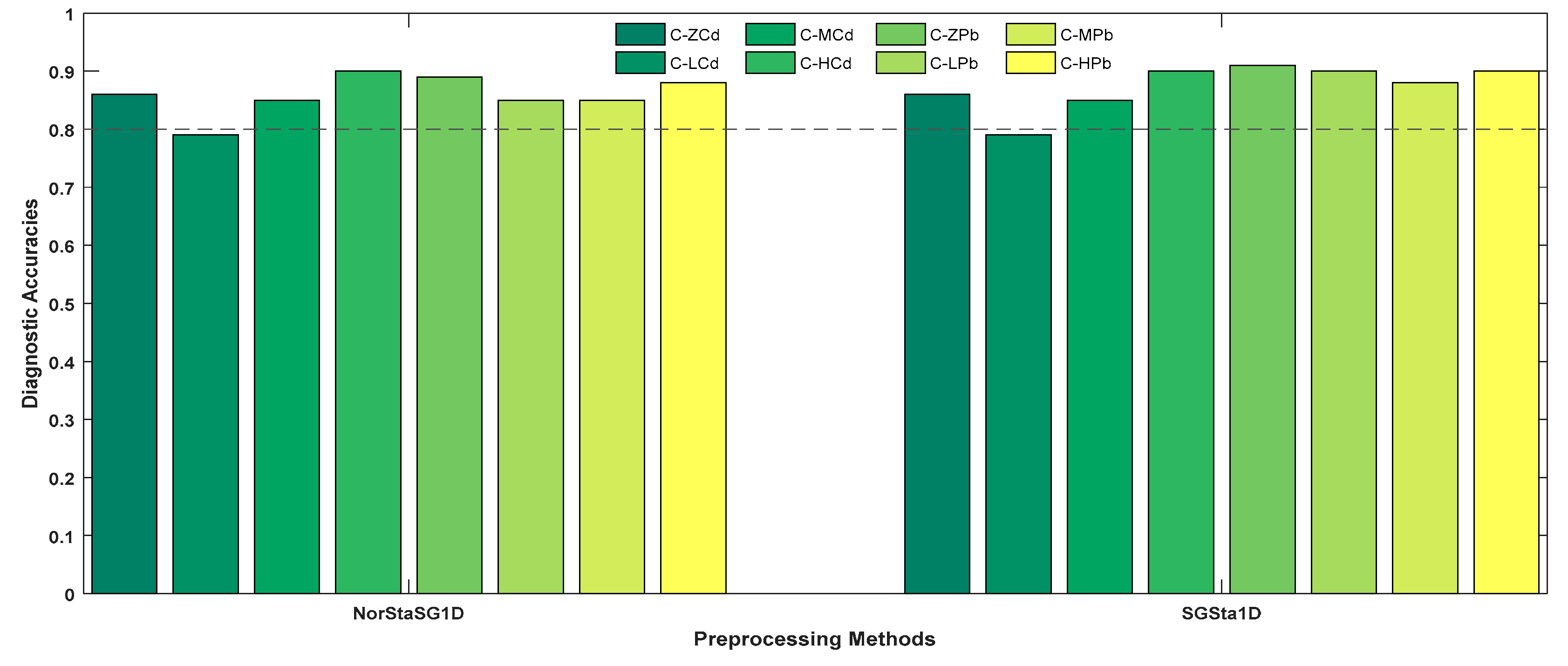
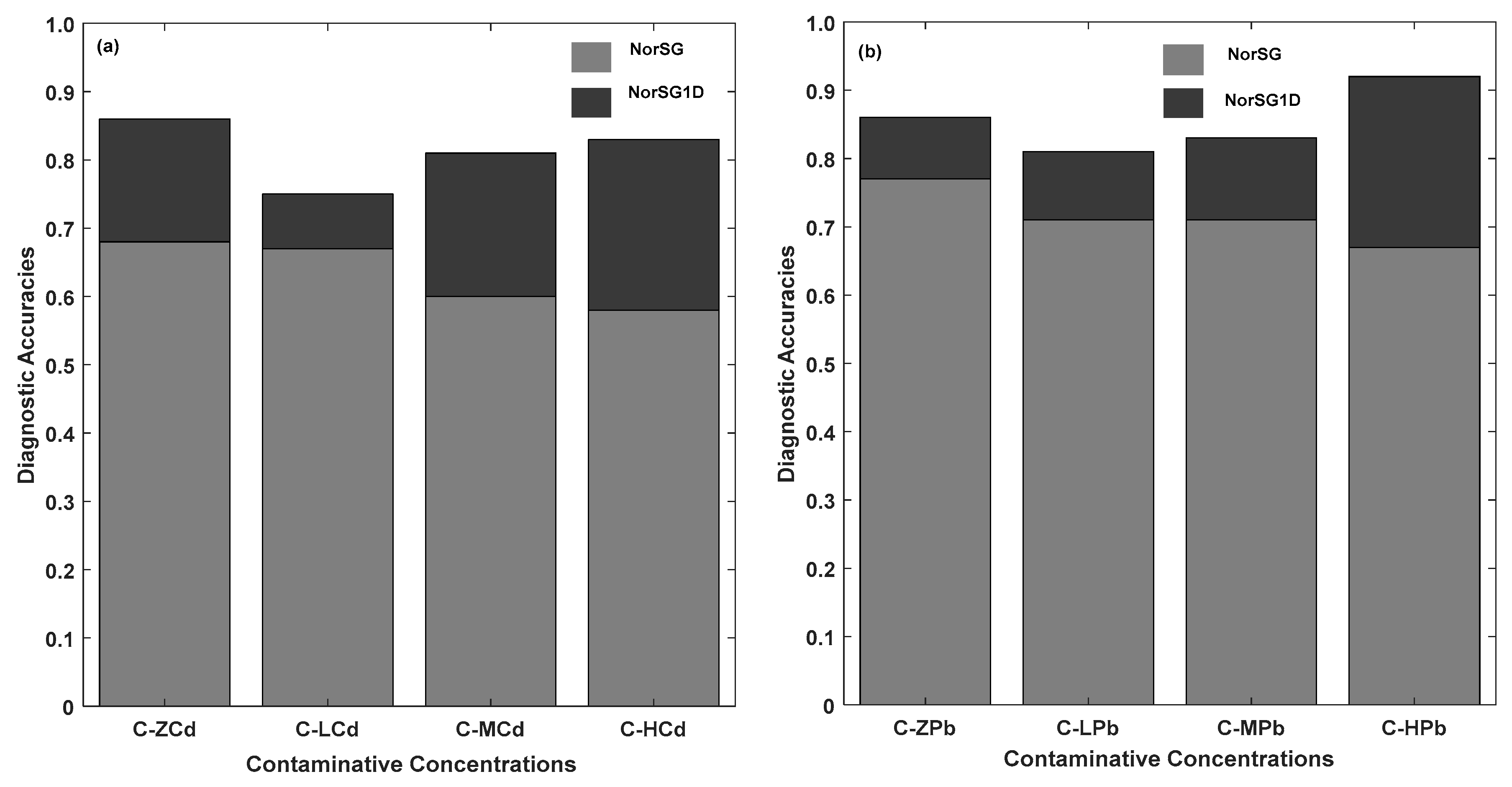
| Pre-processing Methods | Abbreviations |
|---|---|
| Normalization + Savitzky–Golay smoothing + 1st-Derivative | NorSG1D |
| Savitzky–Golay smoothing + normalization + 1st-Derivative | SGNor1D |
| Savitzky–Golay smoothing + normalization + 2nd-Derivative | SGNor2D |
| Savitzky–Golay smoothing + standardization + 1st-Derivative | SGSta1D |
| Savitzky–Golay smoothing + standardization + 2nd-Derivative | SGSta2D |
| Normalization + standardization + Savitzky–Golay smoothing + 1st-Derivative | NorStaSG1D |
| Normalization + standardization + Savitzky–Golay smoothing + 2nd-Derivative | NorStaSG1D |
| Normalization + Savitzky–Golay smoothing + standardization + 1st-Derivative | NorSGSta1D |
| Normalization + Savitzky–Golay smoothing + standardization + 2nd-Derivative | NorSGSta2D |
| Standardization + Savitzky–Golay smoothing + normalization + 1st-Derivative | StaSGNor1D |
| Cd Contents Measured | Pb Contents Measured | |||||
|---|---|---|---|---|---|---|
| Whole Data Set | Calibration Data Set | Validation Data Set | Whole Data Set | Calibration Data Set | Validation Data Set | |
| num | 96 | 64 | 32 | 96 | 64 | 32 |
| maximum | 45.48 | 45.48 | 45.48 | 814.91 | 814.91 | 814.91 |
| minimum | 0 | 0 | 0 | 0 | 0 | 0 |
| mean | 12.96 | 13.29 | 12.31 | 240.87 | 230.36 | 261.88 |
| SD | 11.93 | 11.66 | 12.62 | 270.23 | 269.04 | 275.69 |
| Sample Number | Correct Diagnosis | Incorrect Diagnosis | Accuracy | |
|---|---|---|---|---|
| C–ZPb | 24 | 21 | 3 | 0.88 |
| Other Stress Levels | 72 | 64 | 8 | 0.89 |
| Statistical data | 96 | 85 | 11 | 0.89 |
| Pretreatment methods | Diagnostic accuracies of Cd | Diagnostic accuracies of Pb | ||||||
|---|---|---|---|---|---|---|---|---|
| C–ZCd | C–LCd | C–MCd | C–HCd | C–ZPb | C–LPb | C–MPb | C–HPd | |
| NorSG1D | 0.86 | 0.75 | 0.81 | 0.83 | 0.86 | 0.81 | 0.83 | 0.92 |
| NorStaSG1D | 0.86 | 0.79 | 0.85 | 0.90 | 0.89 | 0.85 | 0.85 | 0.88 |
| NorStaSG2D | 0.81 | 0.77 | 0.81 | 0.81 | 0.85 | 0.81 | 0.85 | 0.88 |
| NorSGSta1D | 0.85 | 0.75 | 0.88 | 0.88 | 0.91 | 0.90 | 0.88 | 0.90 |
| NorSGSta2D | 0.81 | 0.75 | 0.83 | 0.81 | 0.88 | 0.81 | 0.88 | 0.88 |
| StaSGNor1D | 0.82 | 0.75 | 0.83 | 0.85 | 0.86 | 0.85 | 0.85 | 0.88 |
| SGNor1D | 0.86 | 0.77 | 0.90 | 0.90 | 0.86 | 0.85 | 0.85 | 0.88 |
| SGNor2D | 0.83 | 0.81 | 0.83 | 0.83 | 0.86 | 0.83 | 0.79 | 0.85 |
| SGSta1D | 0.86 | 0.79 | 0.85 | 0.90 | 0.91 | 0.90 | 0.88 | 0.90 |
| SGSta2D | 0.81 | 0.75 | 0.79 | 0.81 | 0.88 | 0.85 | 0.85 | 0.88 |
| Categories | Pre-Processing Methods | Important Bands (\nm) | Refs |
|---|---|---|---|
| Cd | principal component analysis (PCA) | 700–710 | [54] |
| Cd | First derivative(1D) | 372, 374, 478 | [55] |
| Cd | orthogonal signal correction (OSC), ABS, 1D, second derivative(2D), et al. | 590–620, 580–595 | [12] |
| Cd | genetic algorithm (GA) | 481, 563, 616, 718 | [42] |
| Cd | Savitzky–Golay smoothing (SG) | 2100–2300 | [56] |
| Cd | 1D,2D, normalization, standardization | 681, 683, 693, 694, 699, 769–776, 880, 1018, 1461, etc. | This work |
| Pb | PCA | 700–710 | [54] |
| Pb | GA | 617, 735, 2350 | [42] |
| Pb | SG | 710–720, 2100–2300 | [56] |
| Pb | average | 564, 624 | [4] |
| Pb | absorbance transformation (ABS), SG | 400–450, 1000, 2400–2420 | [13] |
| Pb | Fractional order derivative (FOD) | 400–560 | [11] |
| Pb | 1D,2D, normalization, standardization | 712–713, 717–720, 727–728, 751–752, 757–758, 815, etc. | This work |
| Models | Factor Numbers | r2 | RMSE | RPIQ | ||||
|---|---|---|---|---|---|---|---|---|
| Cd | Pb | Cd | Pb | Cd | Pb | Cd | Pb | |
| SVM | 4 | 3 | 0.38 | 0.29 | 50.45 | 421.56 | 9.72 | 15.79 |
| PLSR | 2 | 2 | 0.70 | 0.13 | 10.26 | 303.17 | 1.93 | 7.37 |
| Monitoring Object | Sampling Site | Measuring Site | Monitoring Part | Sample Number | r2 | Reference |
|---|---|---|---|---|---|---|
| Cd | River floodplains | lab | soil | 36 | 0.21 | [54] |
| Cd | Irrigation region | lab | soil | 76 | <0.72 | [12] |
| Cd | - | field | leaf | 36 | 0.86 | [55] |
| Cd | Lake sediment | lab | soil | 103 | 0.47 | [42] |
| Cd | Suburban | lab | soil | 93 | 0.76 | [56] |
| Pb | Mining areas | lab | soil | 214 | 0.73 | [59] |
| Pb | River floodplains | lab | soil | 36 | 0.21 | [54] |
| Pb | Mining areas | lab | soil | 30 | 0.59 | [4] |
| Pb | Paddy field | lab | soil | 14 | 0.46 | [13] |
| Pb | Lake sediment | lab | soil | 103 | 0.41 | [42] |
| Pb | Suburban | lab | soil | 93 | 0.27 | [56] |
© 2020 by the authors. Licensee MDPI, Basel, Switzerland. This article is an open access article distributed under the terms and conditions of the Creative Commons Attribution (CC BY) license (http://creativecommons.org/licenses/by/4.0/).
Share and Cite
Zhang, S.; Li, J.; Wang, S.; Huang, Y.; Li, Y.; Chen, Y.; Fei, T. Rapid Identification and Prediction of Cadmium-Lead Cross-Stress of Different Stress Levels in Rice Canopy Based on Visible and Near-Infrared Spectroscopy. Remote Sens. 2020, 12, 469. https://doi.org/10.3390/rs12030469
Zhang S, Li J, Wang S, Huang Y, Li Y, Chen Y, Fei T. Rapid Identification and Prediction of Cadmium-Lead Cross-Stress of Different Stress Levels in Rice Canopy Based on Visible and Near-Infrared Spectroscopy. Remote Sensing. 2020; 12(3):469. https://doi.org/10.3390/rs12030469
Chicago/Turabian StyleZhang, Shuangyin, Jun Li, Siying Wang, Yingjing Huang, Yizhuo Li, Yiyun Chen, and Teng Fei. 2020. "Rapid Identification and Prediction of Cadmium-Lead Cross-Stress of Different Stress Levels in Rice Canopy Based on Visible and Near-Infrared Spectroscopy" Remote Sensing 12, no. 3: 469. https://doi.org/10.3390/rs12030469






